Comprehensive Literature Review: Change Management in Organizations
VerifiedAdded on 2021/06/16
|12
|3169
|80
Literature Review
AI Summary
This literature review examines the complexities of change management within organizations, highlighting the challenges and strategies for successful implementation. It explores various factors influencing organizational change, including leadership styles, employee engagement, and technological advancements. The review synthesizes research from multiple scholars, such as Tudor, Mosadeghrad, and Lewin, to identify key issues like resistance to change, the importance of a supportive environment, and the role of psychological contracts. It also discusses different types of organizational change (operational, strategic, cultural, and political) and their impact on various levels within the organization. The review emphasizes the need for effective change management models, the significance of understanding external forces, and the importance of leaders creating a vision and institutionalizing changes. Finally, it underscores the importance of technology and the need for fairness and balance in the relationships between employers and employees during the change process.
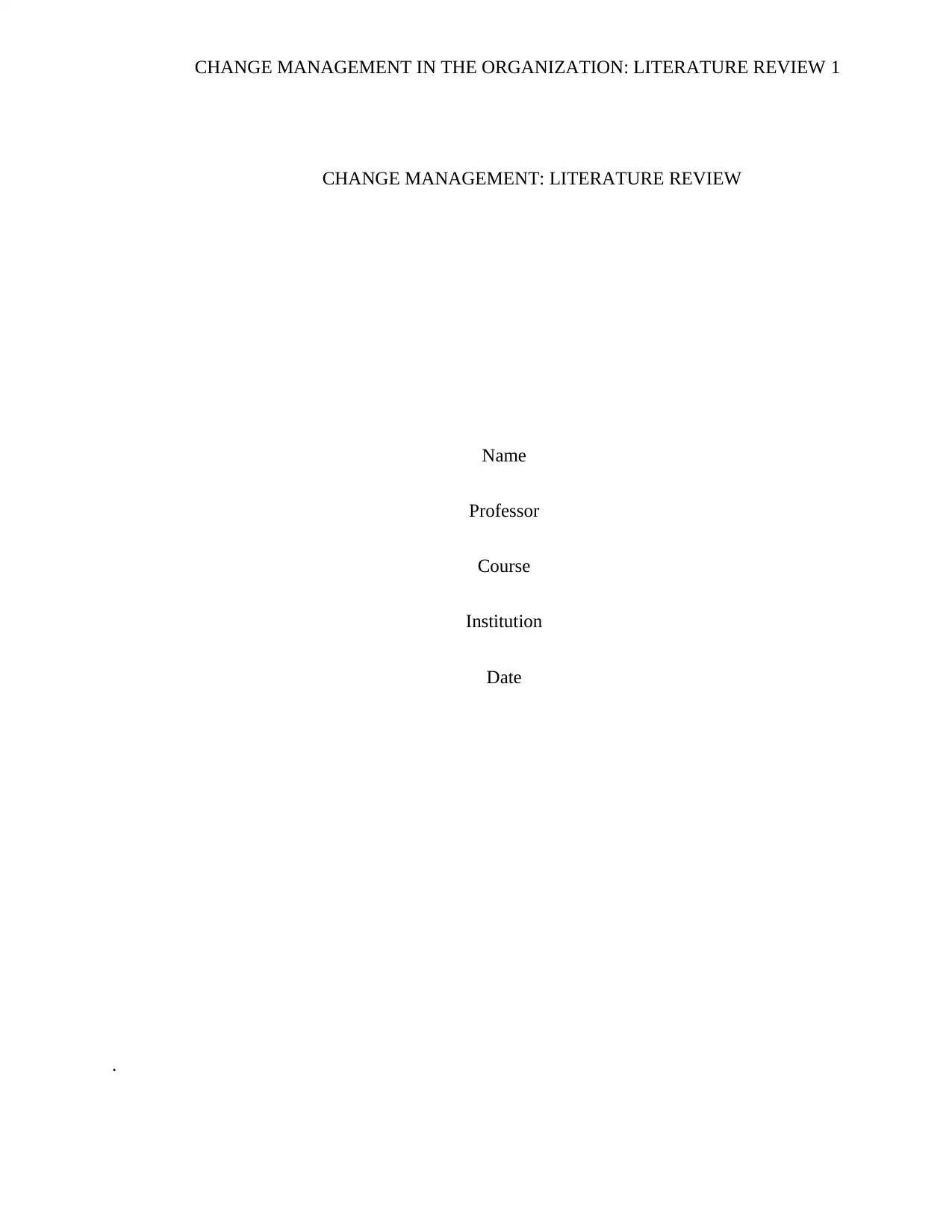
CHANGE MANAGEMENT IN THE ORGANIZATION: LITERATURE REVIEW 1
CHANGE MANAGEMENT: LITERATURE REVIEW
Name
Professor
Course
Institution
Date
.
CHANGE MANAGEMENT: LITERATURE REVIEW
Name
Professor
Course
Institution
Date
.
Paraphrase This Document
Need a fresh take? Get an instant paraphrase of this document with our AI Paraphraser
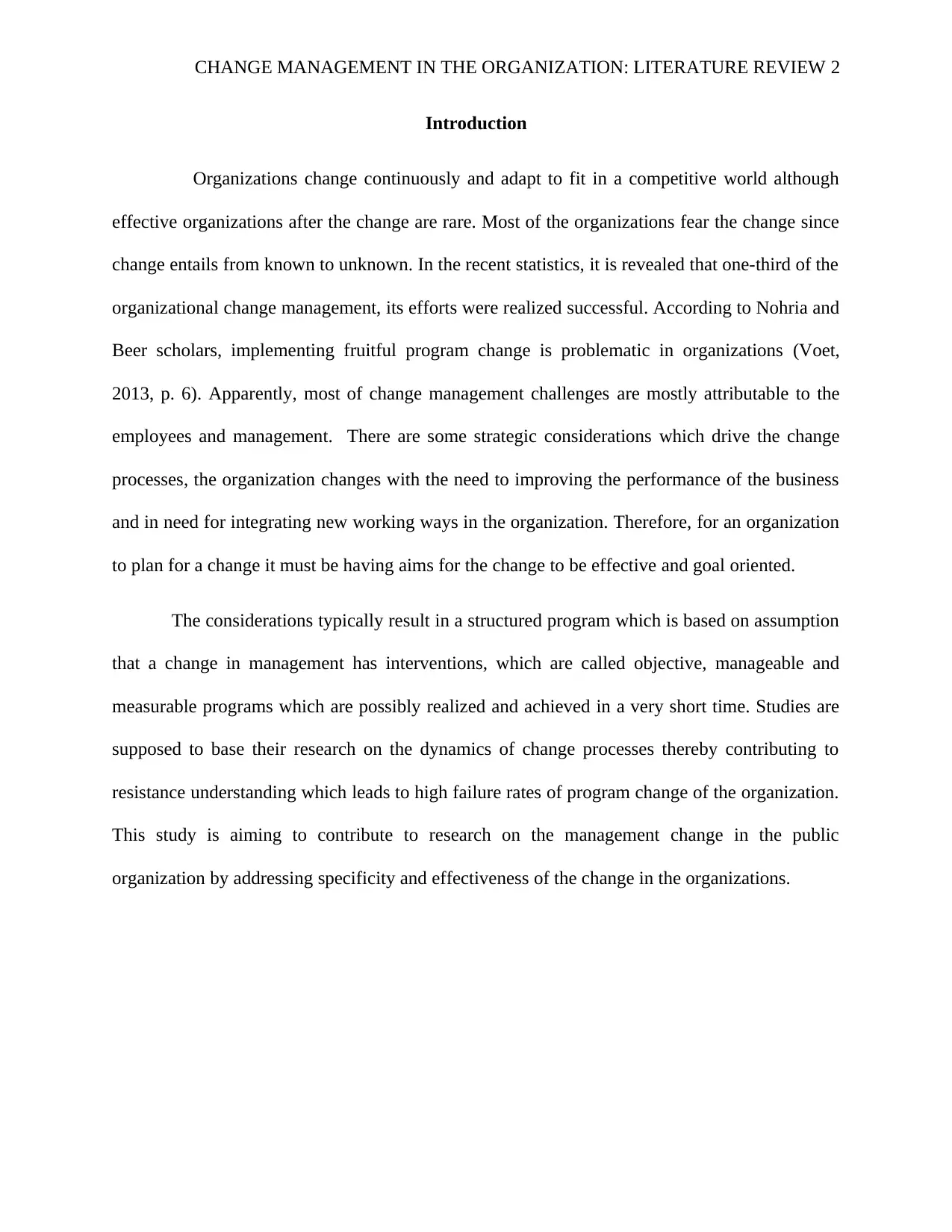
CHANGE MANAGEMENT IN THE ORGANIZATION: LITERATURE REVIEW 2
Introduction
Organizations change continuously and adapt to fit in a competitive world although
effective organizations after the change are rare. Most of the organizations fear the change since
change entails from known to unknown. In the recent statistics, it is revealed that one-third of the
organizational change management, its efforts were realized successful. According to Nohria and
Beer scholars, implementing fruitful program change is problematic in organizations (Voet,
2013, p. 6). Apparently, most of change management challenges are mostly attributable to the
employees and management. There are some strategic considerations which drive the change
processes, the organization changes with the need to improving the performance of the business
and in need for integrating new working ways in the organization. Therefore, for an organization
to plan for a change it must be having aims for the change to be effective and goal oriented.
The considerations typically result in a structured program which is based on assumption
that a change in management has interventions, which are called objective, manageable and
measurable programs which are possibly realized and achieved in a very short time. Studies are
supposed to base their research on the dynamics of change processes thereby contributing to
resistance understanding which leads to high failure rates of program change of the organization.
This study is aiming to contribute to research on the management change in the public
organization by addressing specificity and effectiveness of the change in the organizations.
Introduction
Organizations change continuously and adapt to fit in a competitive world although
effective organizations after the change are rare. Most of the organizations fear the change since
change entails from known to unknown. In the recent statistics, it is revealed that one-third of the
organizational change management, its efforts were realized successful. According to Nohria and
Beer scholars, implementing fruitful program change is problematic in organizations (Voet,
2013, p. 6). Apparently, most of change management challenges are mostly attributable to the
employees and management. There are some strategic considerations which drive the change
processes, the organization changes with the need to improving the performance of the business
and in need for integrating new working ways in the organization. Therefore, for an organization
to plan for a change it must be having aims for the change to be effective and goal oriented.
The considerations typically result in a structured program which is based on assumption
that a change in management has interventions, which are called objective, manageable and
measurable programs which are possibly realized and achieved in a very short time. Studies are
supposed to base their research on the dynamics of change processes thereby contributing to
resistance understanding which leads to high failure rates of program change of the organization.
This study is aiming to contribute to research on the management change in the public
organization by addressing specificity and effectiveness of the change in the organizations.
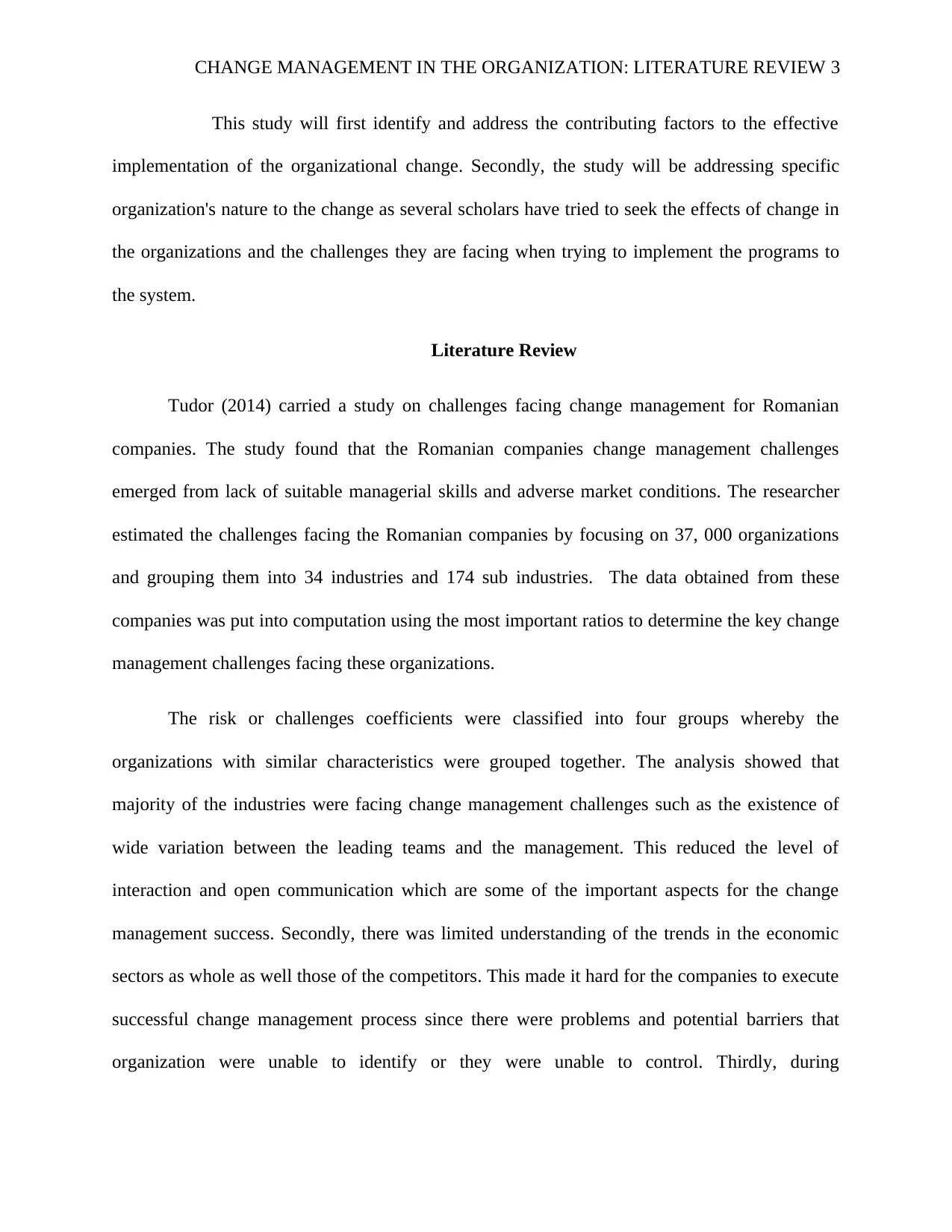
CHANGE MANAGEMENT IN THE ORGANIZATION: LITERATURE REVIEW 3
This study will first identify and address the contributing factors to the effective
implementation of the organizational change. Secondly, the study will be addressing specific
organization's nature to the change as several scholars have tried to seek the effects of change in
the organizations and the challenges they are facing when trying to implement the programs to
the system.
Literature Review
Tudor (2014) carried a study on challenges facing change management for Romanian
companies. The study found that the Romanian companies change management challenges
emerged from lack of suitable managerial skills and adverse market conditions. The researcher
estimated the challenges facing the Romanian companies by focusing on 37, 000 organizations
and grouping them into 34 industries and 174 sub industries. The data obtained from these
companies was put into computation using the most important ratios to determine the key change
management challenges facing these organizations.
The risk or challenges coefficients were classified into four groups whereby the
organizations with similar characteristics were grouped together. The analysis showed that
majority of the industries were facing change management challenges such as the existence of
wide variation between the leading teams and the management. This reduced the level of
interaction and open communication which are some of the important aspects for the change
management success. Secondly, there was limited understanding of the trends in the economic
sectors as whole as well those of the competitors. This made it hard for the companies to execute
successful change management process since there were problems and potential barriers that
organization were unable to identify or they were unable to control. Thirdly, during
This study will first identify and address the contributing factors to the effective
implementation of the organizational change. Secondly, the study will be addressing specific
organization's nature to the change as several scholars have tried to seek the effects of change in
the organizations and the challenges they are facing when trying to implement the programs to
the system.
Literature Review
Tudor (2014) carried a study on challenges facing change management for Romanian
companies. The study found that the Romanian companies change management challenges
emerged from lack of suitable managerial skills and adverse market conditions. The researcher
estimated the challenges facing the Romanian companies by focusing on 37, 000 organizations
and grouping them into 34 industries and 174 sub industries. The data obtained from these
companies was put into computation using the most important ratios to determine the key change
management challenges facing these organizations.
The risk or challenges coefficients were classified into four groups whereby the
organizations with similar characteristics were grouped together. The analysis showed that
majority of the industries were facing change management challenges such as the existence of
wide variation between the leading teams and the management. This reduced the level of
interaction and open communication which are some of the important aspects for the change
management success. Secondly, there was limited understanding of the trends in the economic
sectors as whole as well those of the competitors. This made it hard for the companies to execute
successful change management process since there were problems and potential barriers that
organization were unable to identify or they were unable to control. Thirdly, during
⊘ This is a preview!⊘
Do you want full access?
Subscribe today to unlock all pages.

Trusted by 1+ million students worldwide
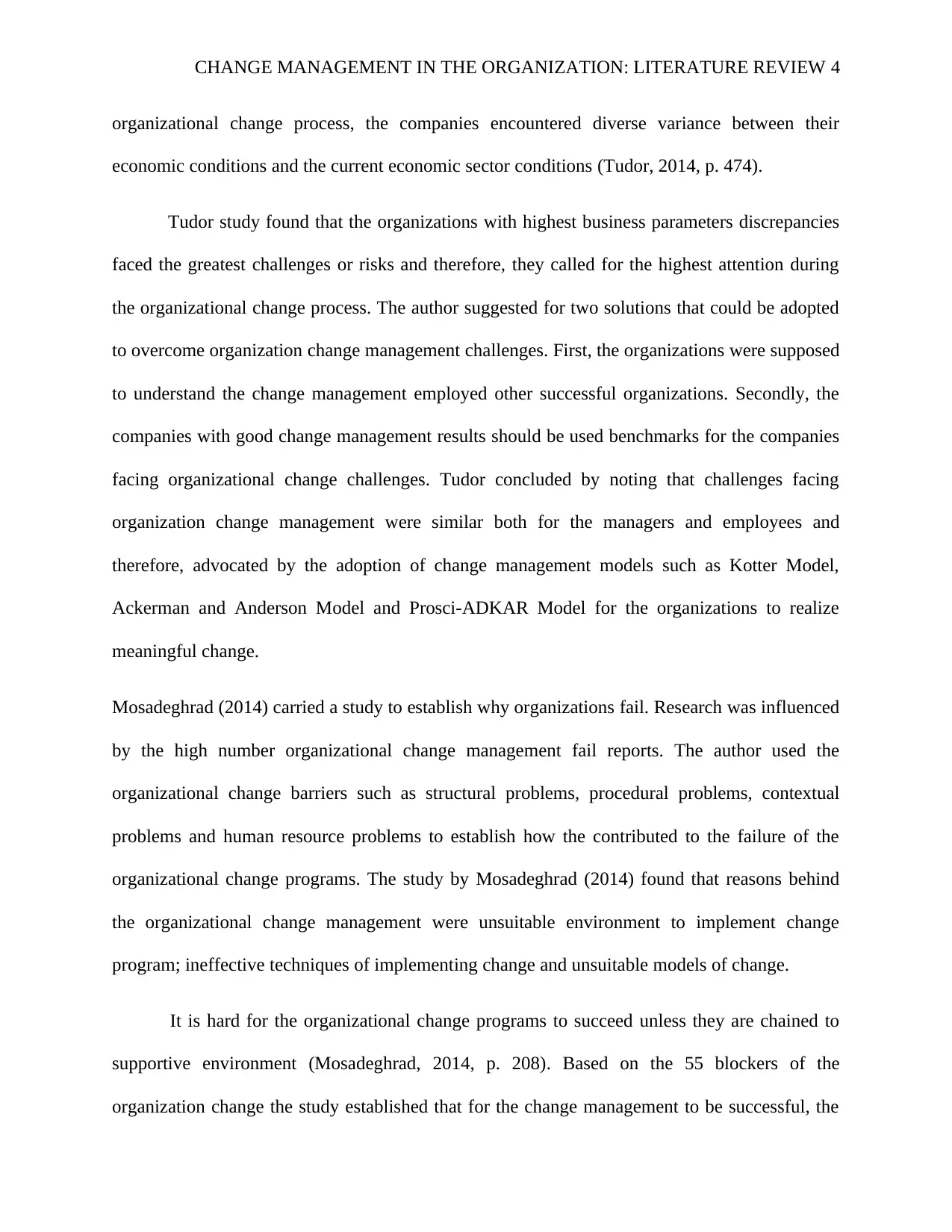
CHANGE MANAGEMENT IN THE ORGANIZATION: LITERATURE REVIEW 4
organizational change process, the companies encountered diverse variance between their
economic conditions and the current economic sector conditions (Tudor, 2014, p. 474).
Tudor study found that the organizations with highest business parameters discrepancies
faced the greatest challenges or risks and therefore, they called for the highest attention during
the organizational change process. The author suggested for two solutions that could be adopted
to overcome organization change management challenges. First, the organizations were supposed
to understand the change management employed other successful organizations. Secondly, the
companies with good change management results should be used benchmarks for the companies
facing organizational change challenges. Tudor concluded by noting that challenges facing
organization change management were similar both for the managers and employees and
therefore, advocated by the adoption of change management models such as Kotter Model,
Ackerman and Anderson Model and Prosci-ADKAR Model for the organizations to realize
meaningful change.
Mosadeghrad (2014) carried a study to establish why organizations fail. Research was influenced
by the high number organizational change management fail reports. The author used the
organizational change barriers such as structural problems, procedural problems, contextual
problems and human resource problems to establish how the contributed to the failure of the
organizational change programs. The study by Mosadeghrad (2014) found that reasons behind
the organizational change management were unsuitable environment to implement change
program; ineffective techniques of implementing change and unsuitable models of change.
It is hard for the organizational change programs to succeed unless they are chained to
supportive environment (Mosadeghrad, 2014, p. 208). Based on the 55 blockers of the
organization change the study established that for the change management to be successful, the
organizational change process, the companies encountered diverse variance between their
economic conditions and the current economic sector conditions (Tudor, 2014, p. 474).
Tudor study found that the organizations with highest business parameters discrepancies
faced the greatest challenges or risks and therefore, they called for the highest attention during
the organizational change process. The author suggested for two solutions that could be adopted
to overcome organization change management challenges. First, the organizations were supposed
to understand the change management employed other successful organizations. Secondly, the
companies with good change management results should be used benchmarks for the companies
facing organizational change challenges. Tudor concluded by noting that challenges facing
organization change management were similar both for the managers and employees and
therefore, advocated by the adoption of change management models such as Kotter Model,
Ackerman and Anderson Model and Prosci-ADKAR Model for the organizations to realize
meaningful change.
Mosadeghrad (2014) carried a study to establish why organizations fail. Research was influenced
by the high number organizational change management fail reports. The author used the
organizational change barriers such as structural problems, procedural problems, contextual
problems and human resource problems to establish how the contributed to the failure of the
organizational change programs. The study by Mosadeghrad (2014) found that reasons behind
the organizational change management were unsuitable environment to implement change
program; ineffective techniques of implementing change and unsuitable models of change.
It is hard for the organizational change programs to succeed unless they are chained to
supportive environment (Mosadeghrad, 2014, p. 208). Based on the 55 blockers of the
organization change the study established that for the change management to be successful, the
Paraphrase This Document
Need a fresh take? Get an instant paraphrase of this document with our AI Paraphraser
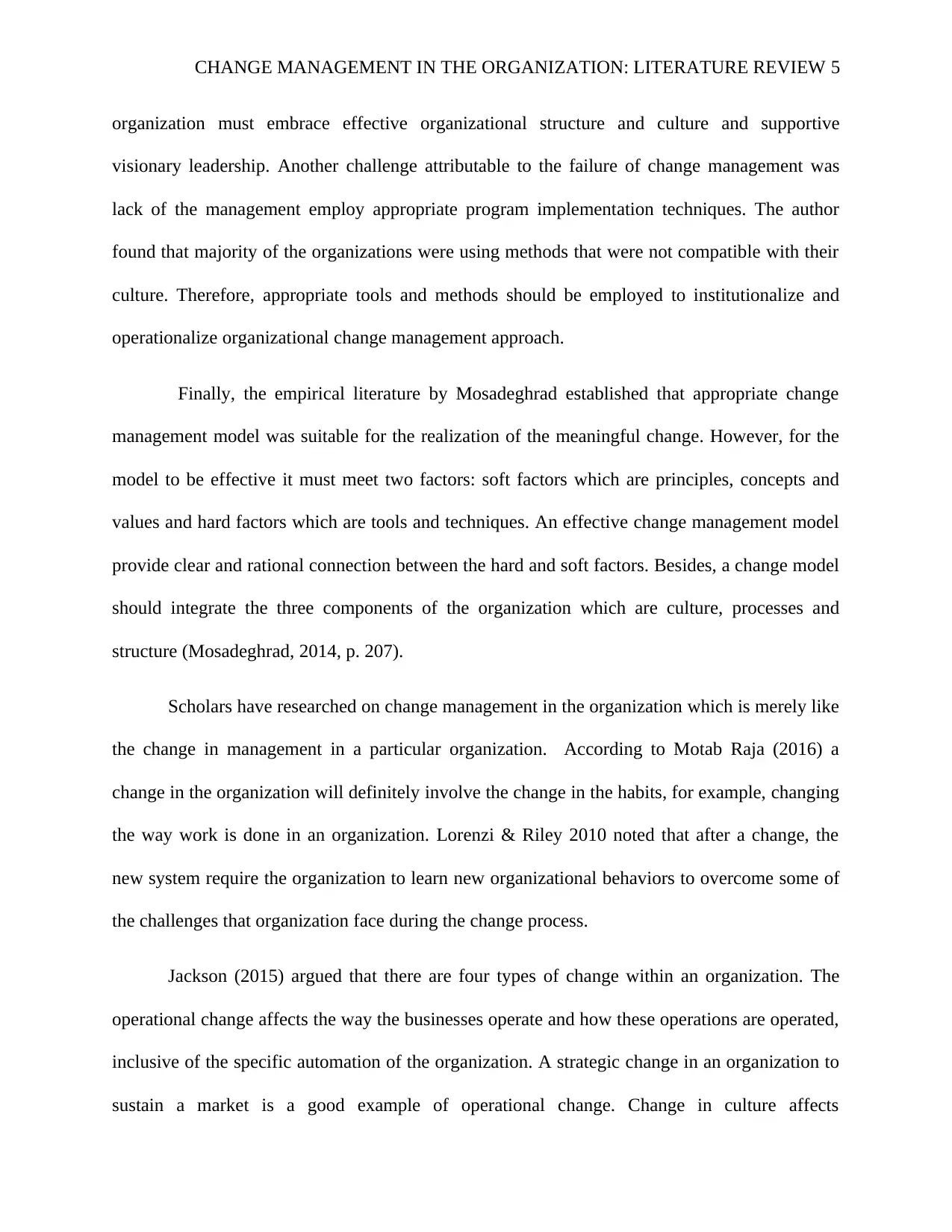
CHANGE MANAGEMENT IN THE ORGANIZATION: LITERATURE REVIEW 5
organization must embrace effective organizational structure and culture and supportive
visionary leadership. Another challenge attributable to the failure of change management was
lack of the management employ appropriate program implementation techniques. The author
found that majority of the organizations were using methods that were not compatible with their
culture. Therefore, appropriate tools and methods should be employed to institutionalize and
operationalize organizational change management approach.
Finally, the empirical literature by Mosadeghrad established that appropriate change
management model was suitable for the realization of the meaningful change. However, for the
model to be effective it must meet two factors: soft factors which are principles, concepts and
values and hard factors which are tools and techniques. An effective change management model
provide clear and rational connection between the hard and soft factors. Besides, a change model
should integrate the three components of the organization which are culture, processes and
structure (Mosadeghrad, 2014, p. 207).
Scholars have researched on change management in the organization which is merely like
the change in management in a particular organization. According to Motab Raja (2016) a
change in the organization will definitely involve the change in the habits, for example, changing
the way work is done in an organization. Lorenzi & Riley 2010 noted that after a change, the
new system require the organization to learn new organizational behaviors to overcome some of
the challenges that organization face during the change process.
Jackson (2015) argued that there are four types of change within an organization. The
operational change affects the way the businesses operate and how these operations are operated,
inclusive of the specific automation of the organization. A strategic change in an organization to
sustain a market is a good example of operational change. Change in culture affects
organization must embrace effective organizational structure and culture and supportive
visionary leadership. Another challenge attributable to the failure of change management was
lack of the management employ appropriate program implementation techniques. The author
found that majority of the organizations were using methods that were not compatible with their
culture. Therefore, appropriate tools and methods should be employed to institutionalize and
operationalize organizational change management approach.
Finally, the empirical literature by Mosadeghrad established that appropriate change
management model was suitable for the realization of the meaningful change. However, for the
model to be effective it must meet two factors: soft factors which are principles, concepts and
values and hard factors which are tools and techniques. An effective change management model
provide clear and rational connection between the hard and soft factors. Besides, a change model
should integrate the three components of the organization which are culture, processes and
structure (Mosadeghrad, 2014, p. 207).
Scholars have researched on change management in the organization which is merely like
the change in management in a particular organization. According to Motab Raja (2016) a
change in the organization will definitely involve the change in the habits, for example, changing
the way work is done in an organization. Lorenzi & Riley 2010 noted that after a change, the
new system require the organization to learn new organizational behaviors to overcome some of
the challenges that organization face during the change process.
Jackson (2015) argued that there are four types of change within an organization. The
operational change affects the way the businesses operate and how these operations are operated,
inclusive of the specific automation of the organization. A strategic change in an organization to
sustain a market is a good example of operational change. Change in culture affects
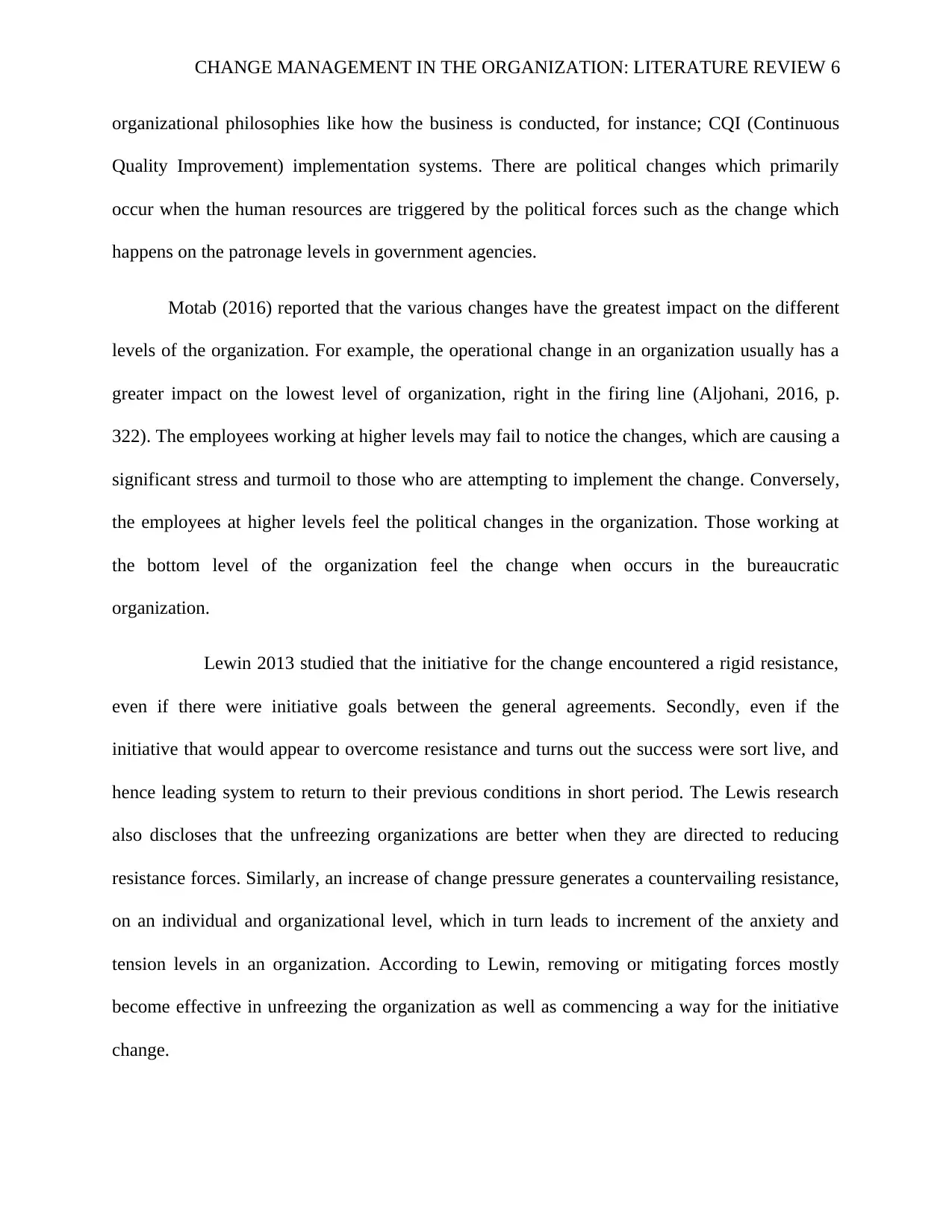
CHANGE MANAGEMENT IN THE ORGANIZATION: LITERATURE REVIEW 6
organizational philosophies like how the business is conducted, for instance; CQI (Continuous
Quality Improvement) implementation systems. There are political changes which primarily
occur when the human resources are triggered by the political forces such as the change which
happens on the patronage levels in government agencies.
Motab (2016) reported that the various changes have the greatest impact on the different
levels of the organization. For example, the operational change in an organization usually has a
greater impact on the lowest level of organization, right in the firing line (Aljohani, 2016, p.
322). The employees working at higher levels may fail to notice the changes, which are causing a
significant stress and turmoil to those who are attempting to implement the change. Conversely,
the employees at higher levels feel the political changes in the organization. Those working at
the bottom level of the organization feel the change when occurs in the bureaucratic
organization.
Lewin 2013 studied that the initiative for the change encountered a rigid resistance,
even if there were initiative goals between the general agreements. Secondly, even if the
initiative that would appear to overcome resistance and turns out the success were sort live, and
hence leading system to return to their previous conditions in short period. The Lewis research
also discloses that the unfreezing organizations are better when they are directed to reducing
resistance forces. Similarly, an increase of change pressure generates a countervailing resistance,
on an individual and organizational level, which in turn leads to increment of the anxiety and
tension levels in an organization. According to Lewin, removing or mitigating forces mostly
become effective in unfreezing the organization as well as commencing a way for the initiative
change.
organizational philosophies like how the business is conducted, for instance; CQI (Continuous
Quality Improvement) implementation systems. There are political changes which primarily
occur when the human resources are triggered by the political forces such as the change which
happens on the patronage levels in government agencies.
Motab (2016) reported that the various changes have the greatest impact on the different
levels of the organization. For example, the operational change in an organization usually has a
greater impact on the lowest level of organization, right in the firing line (Aljohani, 2016, p.
322). The employees working at higher levels may fail to notice the changes, which are causing a
significant stress and turmoil to those who are attempting to implement the change. Conversely,
the employees at higher levels feel the political changes in the organization. Those working at
the bottom level of the organization feel the change when occurs in the bureaucratic
organization.
Lewin 2013 studied that the initiative for the change encountered a rigid resistance,
even if there were initiative goals between the general agreements. Secondly, even if the
initiative that would appear to overcome resistance and turns out the success were sort live, and
hence leading system to return to their previous conditions in short period. The Lewis research
also discloses that the unfreezing organizations are better when they are directed to reducing
resistance forces. Similarly, an increase of change pressure generates a countervailing resistance,
on an individual and organizational level, which in turn leads to increment of the anxiety and
tension levels in an organization. According to Lewin, removing or mitigating forces mostly
become effective in unfreezing the organization as well as commencing a way for the initiative
change.
⊘ This is a preview!⊘
Do you want full access?
Subscribe today to unlock all pages.

Trusted by 1+ million students worldwide
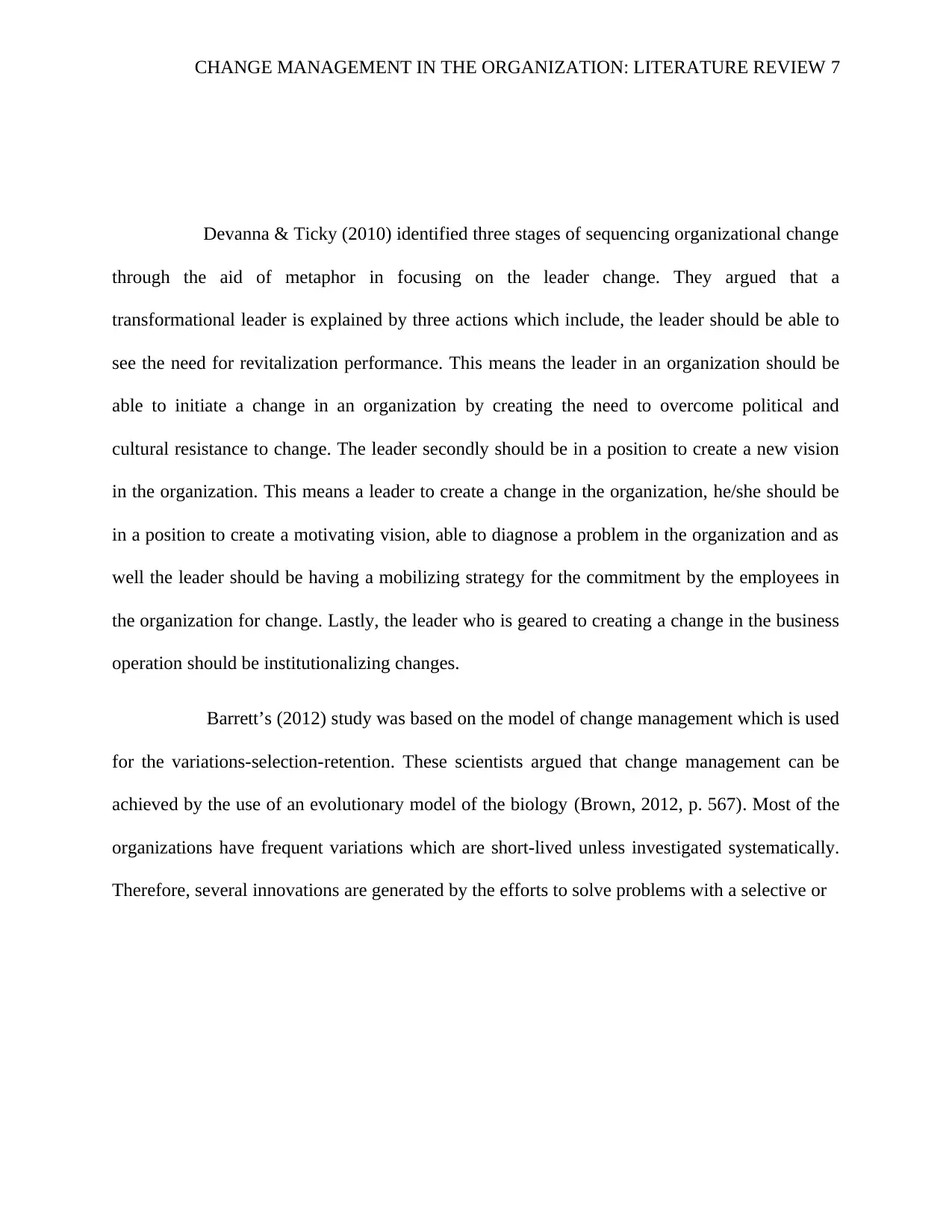
CHANGE MANAGEMENT IN THE ORGANIZATION: LITERATURE REVIEW 7
Devanna & Ticky (2010) identified three stages of sequencing organizational change
through the aid of metaphor in focusing on the leader change. They argued that a
transformational leader is explained by three actions which include, the leader should be able to
see the need for revitalization performance. This means the leader in an organization should be
able to initiate a change in an organization by creating the need to overcome political and
cultural resistance to change. The leader secondly should be in a position to create a new vision
in the organization. This means a leader to create a change in the organization, he/she should be
in a position to create a motivating vision, able to diagnose a problem in the organization and as
well the leader should be having a mobilizing strategy for the commitment by the employees in
the organization for change. Lastly, the leader who is geared to creating a change in the business
operation should be institutionalizing changes.
Barrett’s (2012) study was based on the model of change management which is used
for the variations-selection-retention. These scientists argued that change management can be
achieved by the use of an evolutionary model of the biology (Brown, 2012, p. 567). Most of the
organizations have frequent variations which are short-lived unless investigated systematically.
Therefore, several innovations are generated by the efforts to solve problems with a selective or
Devanna & Ticky (2010) identified three stages of sequencing organizational change
through the aid of metaphor in focusing on the leader change. They argued that a
transformational leader is explained by three actions which include, the leader should be able to
see the need for revitalization performance. This means the leader in an organization should be
able to initiate a change in an organization by creating the need to overcome political and
cultural resistance to change. The leader secondly should be in a position to create a new vision
in the organization. This means a leader to create a change in the organization, he/she should be
in a position to create a motivating vision, able to diagnose a problem in the organization and as
well the leader should be having a mobilizing strategy for the commitment by the employees in
the organization for change. Lastly, the leader who is geared to creating a change in the business
operation should be institutionalizing changes.
Barrett’s (2012) study was based on the model of change management which is used
for the variations-selection-retention. These scientists argued that change management can be
achieved by the use of an evolutionary model of the biology (Brown, 2012, p. 567). Most of the
organizations have frequent variations which are short-lived unless investigated systematically.
Therefore, several innovations are generated by the efforts to solve problems with a selective or
Paraphrase This Document
Need a fresh take? Get an instant paraphrase of this document with our AI Paraphraser
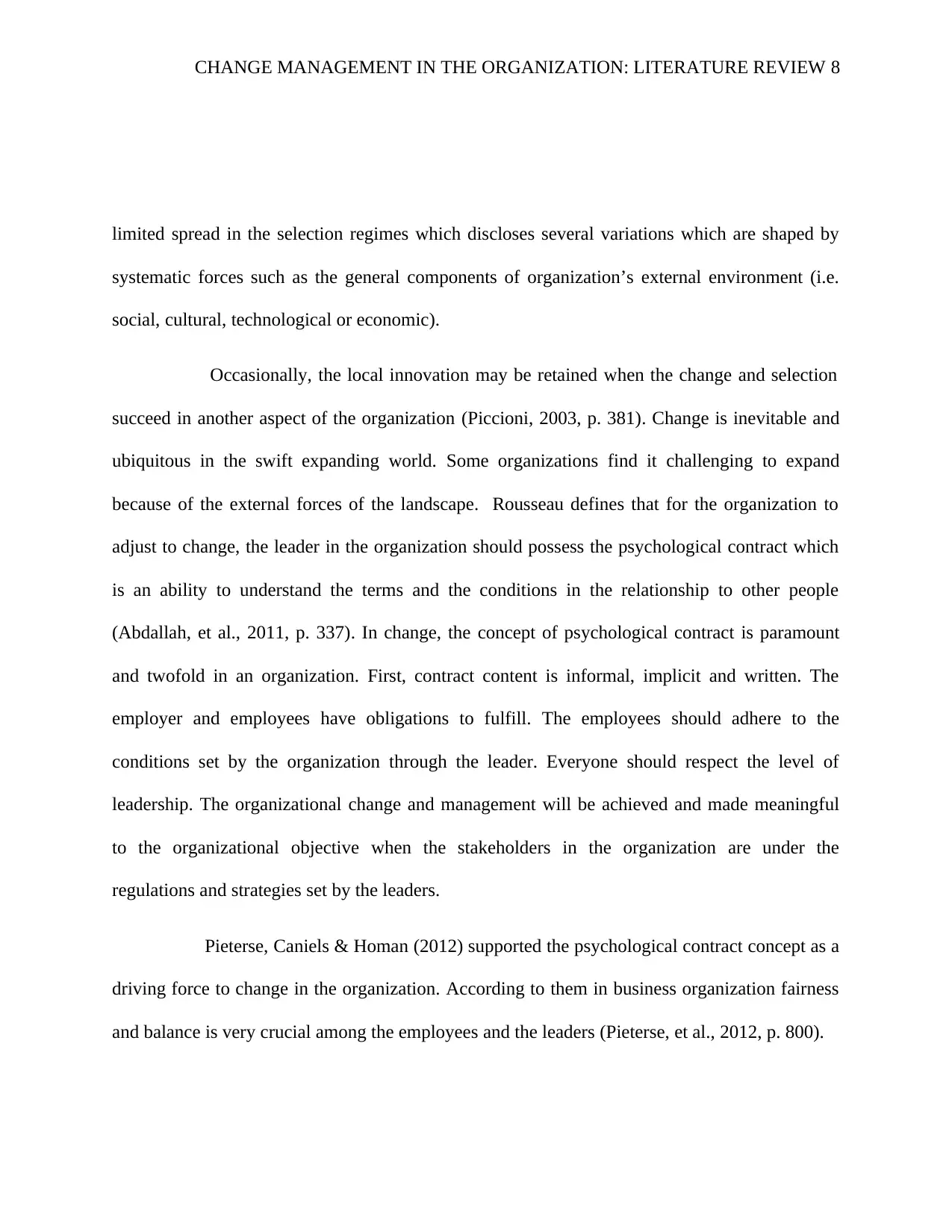
CHANGE MANAGEMENT IN THE ORGANIZATION: LITERATURE REVIEW 8
limited spread in the selection regimes which discloses several variations which are shaped by
systematic forces such as the general components of organization’s external environment (i.e.
social, cultural, technological or economic).
Occasionally, the local innovation may be retained when the change and selection
succeed in another aspect of the organization (Piccioni, 2003, p. 381). Change is inevitable and
ubiquitous in the swift expanding world. Some organizations find it challenging to expand
because of the external forces of the landscape. Rousseau defines that for the organization to
adjust to change, the leader in the organization should possess the psychological contract which
is an ability to understand the terms and the conditions in the relationship to other people
(Abdallah, et al., 2011, p. 337). In change, the concept of psychological contract is paramount
and twofold in an organization. First, contract content is informal, implicit and written. The
employer and employees have obligations to fulfill. The employees should adhere to the
conditions set by the organization through the leader. Everyone should respect the level of
leadership. The organizational change and management will be achieved and made meaningful
to the organizational objective when the stakeholders in the organization are under the
regulations and strategies set by the leaders.
Pieterse, Caniels & Homan (2012) supported the psychological contract concept as a
driving force to change in the organization. According to them in business organization fairness
and balance is very crucial among the employees and the leaders (Pieterse, et al., 2012, p. 800).
limited spread in the selection regimes which discloses several variations which are shaped by
systematic forces such as the general components of organization’s external environment (i.e.
social, cultural, technological or economic).
Occasionally, the local innovation may be retained when the change and selection
succeed in another aspect of the organization (Piccioni, 2003, p. 381). Change is inevitable and
ubiquitous in the swift expanding world. Some organizations find it challenging to expand
because of the external forces of the landscape. Rousseau defines that for the organization to
adjust to change, the leader in the organization should possess the psychological contract which
is an ability to understand the terms and the conditions in the relationship to other people
(Abdallah, et al., 2011, p. 337). In change, the concept of psychological contract is paramount
and twofold in an organization. First, contract content is informal, implicit and written. The
employer and employees have obligations to fulfill. The employees should adhere to the
conditions set by the organization through the leader. Everyone should respect the level of
leadership. The organizational change and management will be achieved and made meaningful
to the organizational objective when the stakeholders in the organization are under the
regulations and strategies set by the leaders.
Pieterse, Caniels & Homan (2012) supported the psychological contract concept as a
driving force to change in the organization. According to them in business organization fairness
and balance is very crucial among the employees and the leaders (Pieterse, et al., 2012, p. 800).
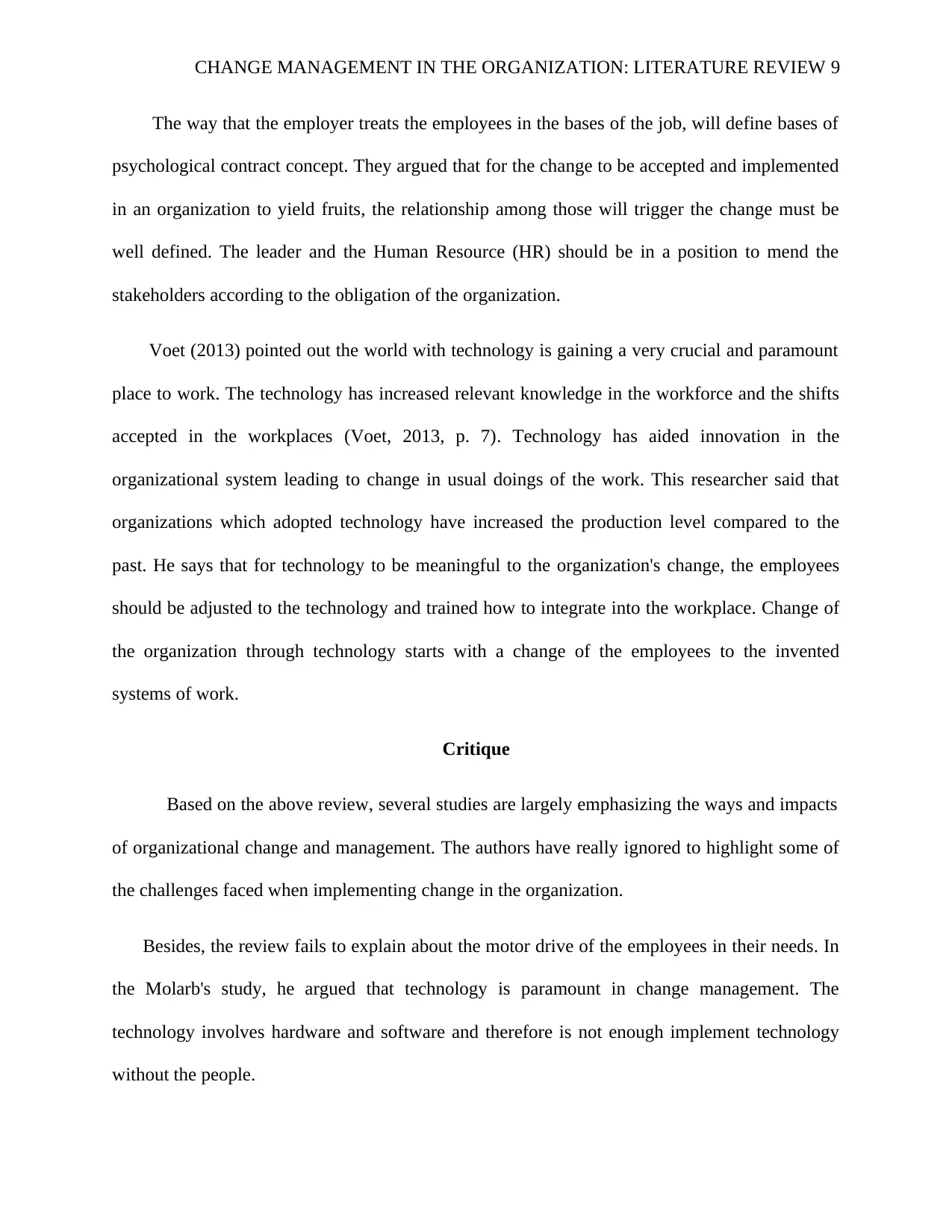
CHANGE MANAGEMENT IN THE ORGANIZATION: LITERATURE REVIEW 9
The way that the employer treats the employees in the bases of the job, will define bases of
psychological contract concept. They argued that for the change to be accepted and implemented
in an organization to yield fruits, the relationship among those will trigger the change must be
well defined. The leader and the Human Resource (HR) should be in a position to mend the
stakeholders according to the obligation of the organization.
Voet (2013) pointed out the world with technology is gaining a very crucial and paramount
place to work. The technology has increased relevant knowledge in the workforce and the shifts
accepted in the workplaces (Voet, 2013, p. 7). Technology has aided innovation in the
organizational system leading to change in usual doings of the work. This researcher said that
organizations which adopted technology have increased the production level compared to the
past. He says that for technology to be meaningful to the organization's change, the employees
should be adjusted to the technology and trained how to integrate into the workplace. Change of
the organization through technology starts with a change of the employees to the invented
systems of work.
Critique
Based on the above review, several studies are largely emphasizing the ways and impacts
of organizational change and management. The authors have really ignored to highlight some of
the challenges faced when implementing change in the organization.
Besides, the review fails to explain about the motor drive of the employees in their needs. In
the Molarb's study, he argued that technology is paramount in change management. The
technology involves hardware and software and therefore is not enough implement technology
without the people.
The way that the employer treats the employees in the bases of the job, will define bases of
psychological contract concept. They argued that for the change to be accepted and implemented
in an organization to yield fruits, the relationship among those will trigger the change must be
well defined. The leader and the Human Resource (HR) should be in a position to mend the
stakeholders according to the obligation of the organization.
Voet (2013) pointed out the world with technology is gaining a very crucial and paramount
place to work. The technology has increased relevant knowledge in the workforce and the shifts
accepted in the workplaces (Voet, 2013, p. 7). Technology has aided innovation in the
organizational system leading to change in usual doings of the work. This researcher said that
organizations which adopted technology have increased the production level compared to the
past. He says that for technology to be meaningful to the organization's change, the employees
should be adjusted to the technology and trained how to integrate into the workplace. Change of
the organization through technology starts with a change of the employees to the invented
systems of work.
Critique
Based on the above review, several studies are largely emphasizing the ways and impacts
of organizational change and management. The authors have really ignored to highlight some of
the challenges faced when implementing change in the organization.
Besides, the review fails to explain about the motor drive of the employees in their needs. In
the Molarb's study, he argued that technology is paramount in change management. The
technology involves hardware and software and therefore is not enough implement technology
without the people.
⊘ This is a preview!⊘
Do you want full access?
Subscribe today to unlock all pages.

Trusted by 1+ million students worldwide
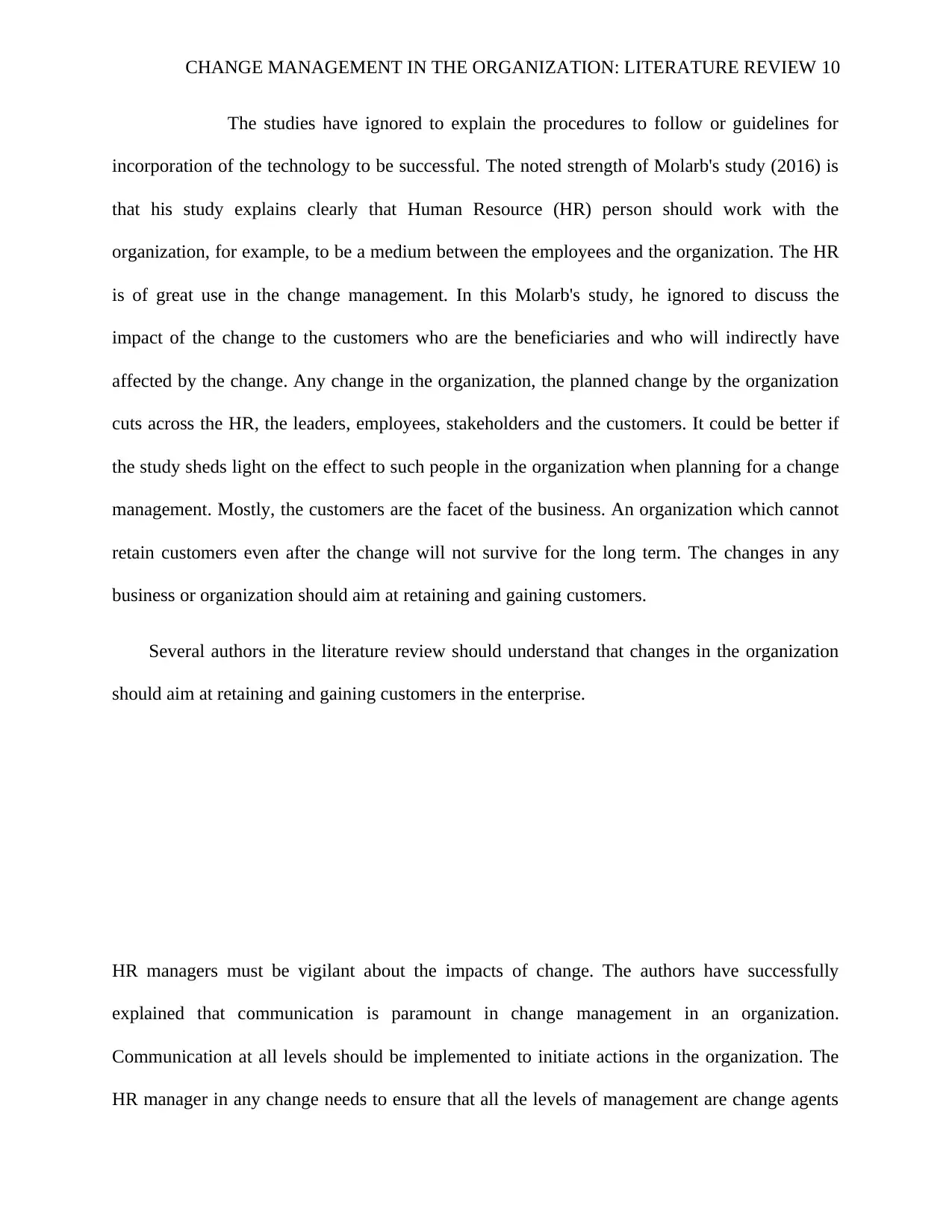
CHANGE MANAGEMENT IN THE ORGANIZATION: LITERATURE REVIEW 10
The studies have ignored to explain the procedures to follow or guidelines for
incorporation of the technology to be successful. The noted strength of Molarb's study (2016) is
that his study explains clearly that Human Resource (HR) person should work with the
organization, for example, to be a medium between the employees and the organization. The HR
is of great use in the change management. In this Molarb's study, he ignored to discuss the
impact of the change to the customers who are the beneficiaries and who will indirectly have
affected by the change. Any change in the organization, the planned change by the organization
cuts across the HR, the leaders, employees, stakeholders and the customers. It could be better if
the study sheds light on the effect to such people in the organization when planning for a change
management. Mostly, the customers are the facet of the business. An organization which cannot
retain customers even after the change will not survive for the long term. The changes in any
business or organization should aim at retaining and gaining customers.
Several authors in the literature review should understand that changes in the organization
should aim at retaining and gaining customers in the enterprise.
HR managers must be vigilant about the impacts of change. The authors have successfully
explained that communication is paramount in change management in an organization.
Communication at all levels should be implemented to initiate actions in the organization. The
HR manager in any change needs to ensure that all the levels of management are change agents
The studies have ignored to explain the procedures to follow or guidelines for
incorporation of the technology to be successful. The noted strength of Molarb's study (2016) is
that his study explains clearly that Human Resource (HR) person should work with the
organization, for example, to be a medium between the employees and the organization. The HR
is of great use in the change management. In this Molarb's study, he ignored to discuss the
impact of the change to the customers who are the beneficiaries and who will indirectly have
affected by the change. Any change in the organization, the planned change by the organization
cuts across the HR, the leaders, employees, stakeholders and the customers. It could be better if
the study sheds light on the effect to such people in the organization when planning for a change
management. Mostly, the customers are the facet of the business. An organization which cannot
retain customers even after the change will not survive for the long term. The changes in any
business or organization should aim at retaining and gaining customers.
Several authors in the literature review should understand that changes in the organization
should aim at retaining and gaining customers in the enterprise.
HR managers must be vigilant about the impacts of change. The authors have successfully
explained that communication is paramount in change management in an organization.
Communication at all levels should be implemented to initiate actions in the organization. The
HR manager in any change needs to ensure that all the levels of management are change agents
Paraphrase This Document
Need a fresh take? Get an instant paraphrase of this document with our AI Paraphraser
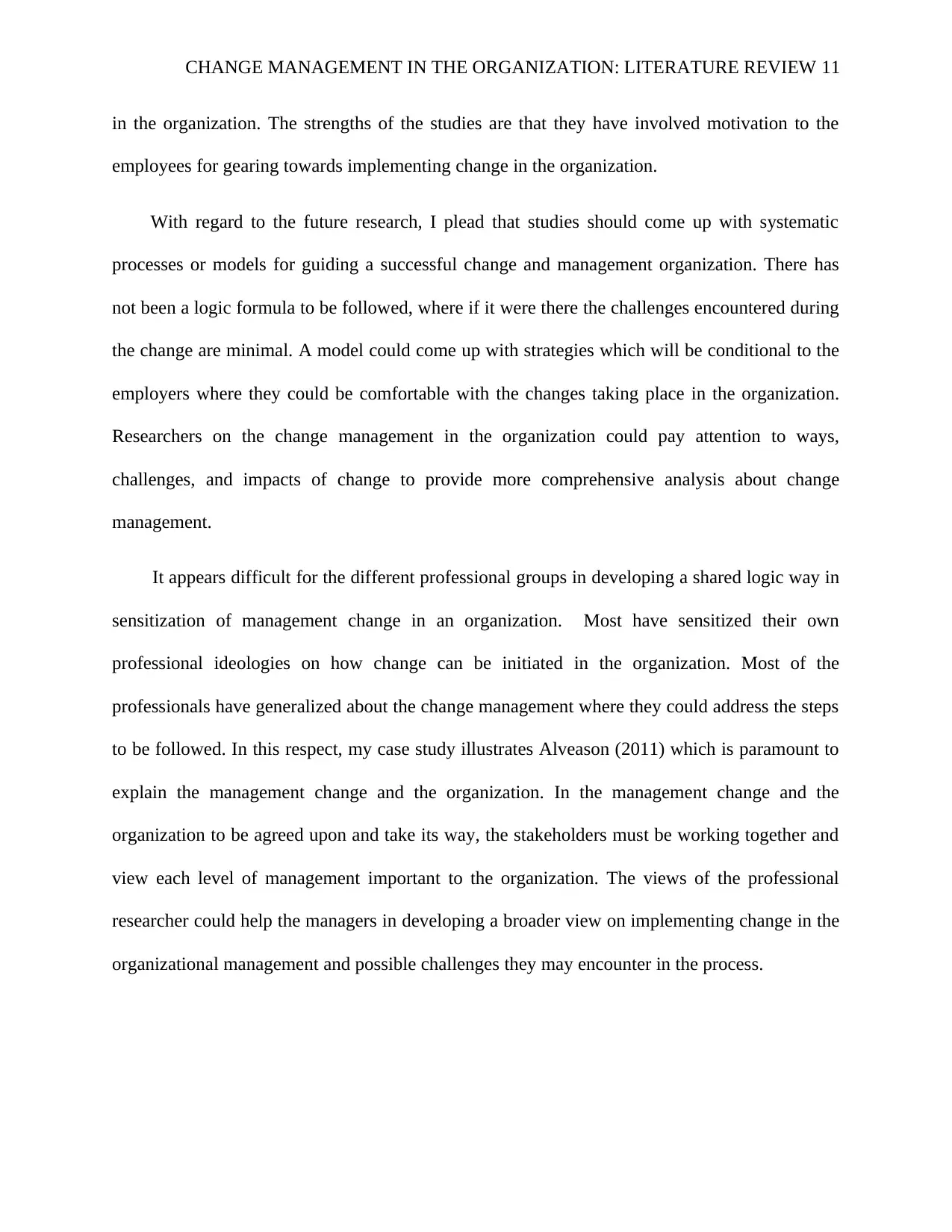
CHANGE MANAGEMENT IN THE ORGANIZATION: LITERATURE REVIEW 11
in the organization. The strengths of the studies are that they have involved motivation to the
employees for gearing towards implementing change in the organization.
With regard to the future research, I plead that studies should come up with systematic
processes or models for guiding a successful change and management organization. There has
not been a logic formula to be followed, where if it were there the challenges encountered during
the change are minimal. A model could come up with strategies which will be conditional to the
employers where they could be comfortable with the changes taking place in the organization.
Researchers on the change management in the organization could pay attention to ways,
challenges, and impacts of change to provide more comprehensive analysis about change
management.
It appears difficult for the different professional groups in developing a shared logic way in
sensitization of management change in an organization. Most have sensitized their own
professional ideologies on how change can be initiated in the organization. Most of the
professionals have generalized about the change management where they could address the steps
to be followed. In this respect, my case study illustrates Alveason (2011) which is paramount to
explain the management change and the organization. In the management change and the
organization to be agreed upon and take its way, the stakeholders must be working together and
view each level of management important to the organization. The views of the professional
researcher could help the managers in developing a broader view on implementing change in the
organizational management and possible challenges they may encounter in the process.
in the organization. The strengths of the studies are that they have involved motivation to the
employees for gearing towards implementing change in the organization.
With regard to the future research, I plead that studies should come up with systematic
processes or models for guiding a successful change and management organization. There has
not been a logic formula to be followed, where if it were there the challenges encountered during
the change are minimal. A model could come up with strategies which will be conditional to the
employers where they could be comfortable with the changes taking place in the organization.
Researchers on the change management in the organization could pay attention to ways,
challenges, and impacts of change to provide more comprehensive analysis about change
management.
It appears difficult for the different professional groups in developing a shared logic way in
sensitization of management change in an organization. Most have sensitized their own
professional ideologies on how change can be initiated in the organization. Most of the
professionals have generalized about the change management where they could address the steps
to be followed. In this respect, my case study illustrates Alveason (2011) which is paramount to
explain the management change and the organization. In the management change and the
organization to be agreed upon and take its way, the stakeholders must be working together and
view each level of management important to the organization. The views of the professional
researcher could help the managers in developing a broader view on implementing change in the
organizational management and possible challenges they may encounter in the process.
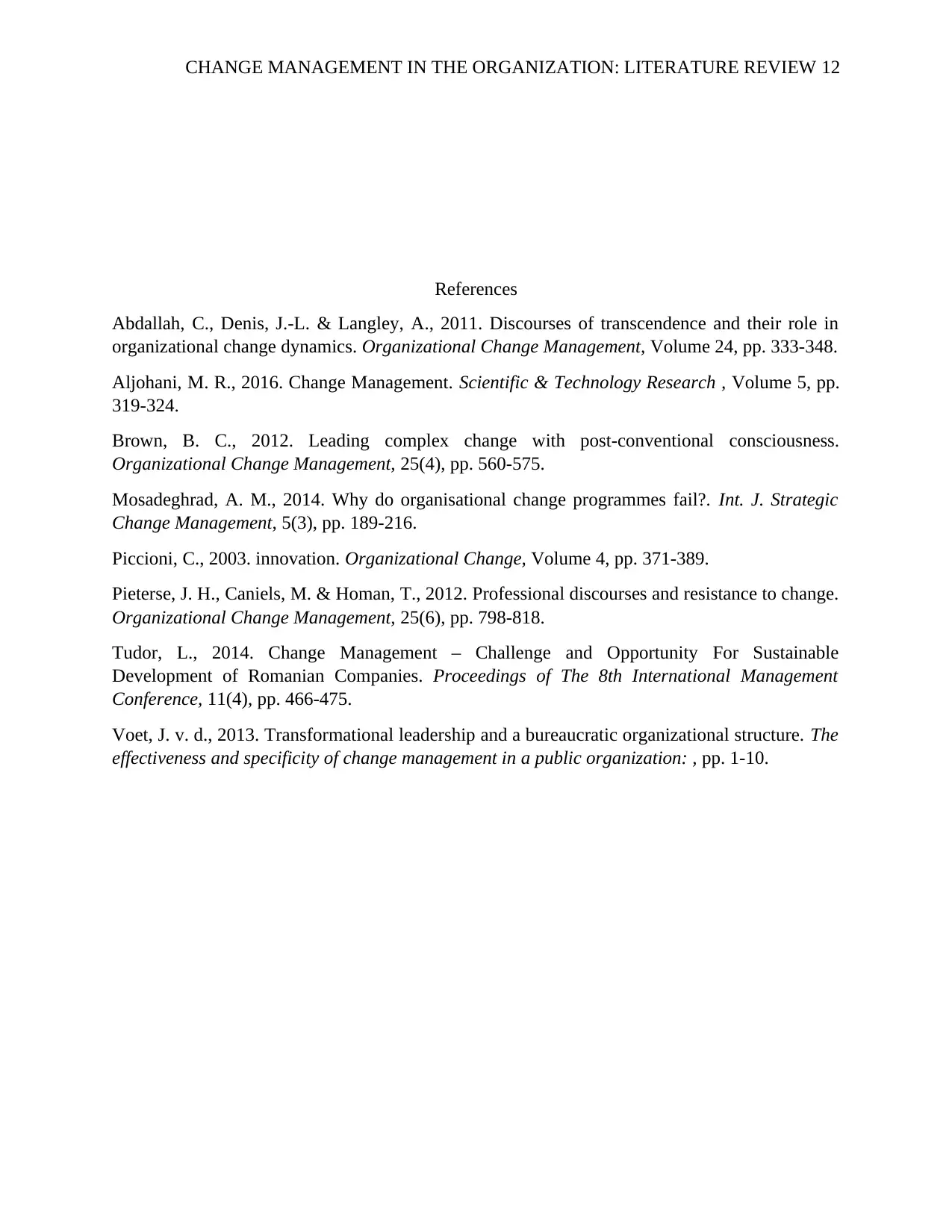
CHANGE MANAGEMENT IN THE ORGANIZATION: LITERATURE REVIEW 12
References
Abdallah, C., Denis, J.-L. & Langley, A., 2011. Discourses of transcendence and their role in
organizational change dynamics. Organizational Change Management, Volume 24, pp. 333-348.
Aljohani, M. R., 2016. Change Management. Scientific & Technology Research , Volume 5, pp.
319-324.
Brown, B. C., 2012. Leading complex change with post-conventional consciousness.
Organizational Change Management, 25(4), pp. 560-575.
Mosadeghrad, A. M., 2014. Why do organisational change programmes fail?. Int. J. Strategic
Change Management, 5(3), pp. 189-216.
Piccioni, C., 2003. innovation. Organizational Change, Volume 4, pp. 371-389.
Pieterse, J. H., Caniels, M. & Homan, T., 2012. Professional discourses and resistance to change.
Organizational Change Management, 25(6), pp. 798-818.
Tudor, L., 2014. Change Management – Challenge and Opportunity For Sustainable
Development of Romanian Companies. Proceedings of The 8th International Management
Conference, 11(4), pp. 466-475.
Voet, J. v. d., 2013. Transformational leadership and a bureaucratic organizational structure. The
effectiveness and specificity of change management in a public organization: , pp. 1-10.
References
Abdallah, C., Denis, J.-L. & Langley, A., 2011. Discourses of transcendence and their role in
organizational change dynamics. Organizational Change Management, Volume 24, pp. 333-348.
Aljohani, M. R., 2016. Change Management. Scientific & Technology Research , Volume 5, pp.
319-324.
Brown, B. C., 2012. Leading complex change with post-conventional consciousness.
Organizational Change Management, 25(4), pp. 560-575.
Mosadeghrad, A. M., 2014. Why do organisational change programmes fail?. Int. J. Strategic
Change Management, 5(3), pp. 189-216.
Piccioni, C., 2003. innovation. Organizational Change, Volume 4, pp. 371-389.
Pieterse, J. H., Caniels, M. & Homan, T., 2012. Professional discourses and resistance to change.
Organizational Change Management, 25(6), pp. 798-818.
Tudor, L., 2014. Change Management – Challenge and Opportunity For Sustainable
Development of Romanian Companies. Proceedings of The 8th International Management
Conference, 11(4), pp. 466-475.
Voet, J. v. d., 2013. Transformational leadership and a bureaucratic organizational structure. The
effectiveness and specificity of change management in a public organization: , pp. 1-10.
⊘ This is a preview!⊘
Do you want full access?
Subscribe today to unlock all pages.

Trusted by 1+ million students worldwide
1 out of 12
Related Documents
Your All-in-One AI-Powered Toolkit for Academic Success.
+13062052269
info@desklib.com
Available 24*7 on WhatsApp / Email
![[object Object]](/_next/static/media/star-bottom.7253800d.svg)
Unlock your academic potential
Copyright © 2020–2025 A2Z Services. All Rights Reserved. Developed and managed by ZUCOL.





